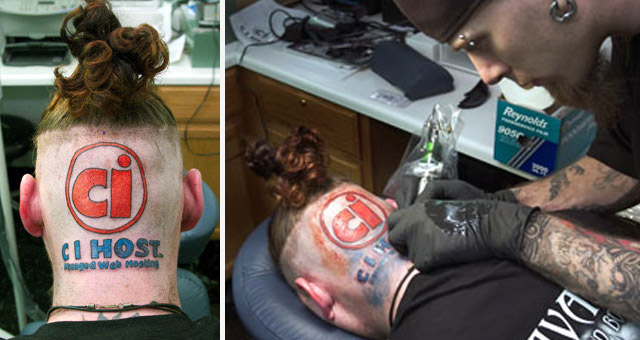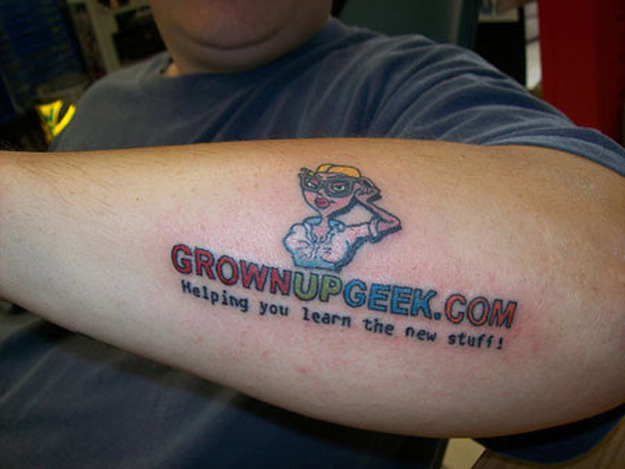The Living Dead Skinvertizing
 Young, daring, energetic, little-known, but very promising dotcoms of the late 90s experienced a desperate need for advertising, which tended to be realized in a completely unusual form. It was then that the first people appeared with tattooed domain names on the skin of the protruding parts of the body.
Young, daring, energetic, little-known, but very promising dotcoms of the late 90s experienced a desperate need for advertising, which tended to be realized in a completely unusual form. It was then that the first people appeared with tattooed domain names on the skin of the protruding parts of the body.In 2003, the first victim of skinvertizing appeared: Jim Nelson from Illinois agreed to turn his nape into an advertising platform of CI Host for 7 thousand dollars. Details of the contract Nelson specifically stipulated that the tattoo with the logo of the hosting company should not be removed in the next 5 years. Only startups could go so crazy, and this trend in its current form is solely their invention - larger and reputable companies would never allow associating themselves with such dubious activities as branding human flesh.
One of the most prominent representatives of live banners is 38-year-old Joe Tamargo, who several years ago put a place on his hands under the hammer. The American thought it was the best place to advertise, and today his hands are covered with 15 tattoos.
')

Jim nelson
New acquaintances of Tamargo are primarily interested in his tattoos, but when they try to access any of the websites in the browser, they sometimes come across a 404 error. Joe's body is an advertisement for an already non-existent business.

Joe Tamargo demonstrates one of the logos.
One of the tattoos of Tamargo mentions the SaveMartha.com website, created to help Martha Stewart. The authorities became aware of the illegal speculations of the end of 2001, and businessmen were charged with securities fraud. Later, Martha went to prison for 5 months and successfully served the sentence, but the tattoo with the slogan that was useless today remained on the skinvertizer's hand.

Do not think that Tamargo does not care about the fate of his customers: for example, he bought pilldaddy.com, the domain name of the site of the former supplier of tablets of male potency, and tried to do at least something with it. In vain. On the other hand, Joe is not going to remove tattoos in the foreseeable future, but he will not add new ones, and if he does, at least for a higher reward.
Tamargo doesn’t easily manage his appearance: he is often mistaken for a criminal, and sometimes he is asked to retire because his addresses and porn sites are placed on his face and hands, but tattoos allowed him to earn 220 thousand dollars for his family, and now the advertisement remains a proud reminder about it.
Another of the most famous skinvertizers is Caroline Smith (now Williams). In 2005, a young mother from the state of Utah sold a place on her forehead to the online casino GoldenPalace.com for 10 thousand dollars that she needed for her son’s private school. It is not known for how long the money was enough for her, but due to changes in US legislation, Golden Palace is not working today, and in some states the domain name is blocked by Caroline.

Golden Palace has also commissioned such an advertisement from Tamargo and a person from Alaska named Hostgator Dotcom (formerly Billy Gibby). The name of the last walking banner is an illustration of another type of viral marketing of the mid-two thousandth: name changes (or part of it, as Kim Dotk did) in consonance with the domain name of the site of the advertised company. Gibby's name became the property of the hostgator.com web host.

Of the 37 promotional tattoos placed for the sake of providing families and children, most are on the skin skintizer face. Today, Dotcom is one of the last people in the world who sell space on their own bodies like a banner platform, and since the media’s interest in this type of advertising has faded noticeably, it does so at bargain prices - about a thousand dollars per piece. Dotcom monitors the content of the advertised sites, and in case of their disappearance, a new customer’s tattoo appears on the body over the old one.
The spread of other types of information reports, vivid attention to this media, and fatigue from the outrageous rent of the body brought closer the extinction of interest in skinvertizing, and by the end of the zero trends, the trend disappeared, like many companies branding several hundred people. With regard to the consequences, advertising in the form of a tattoo on a person’s face is not at all the same as renting airtime or banner space, and today it’s unlikely that you will be able to get to the desired website by typing its address on the face of one of the live billboards.
Based on Buzzfeed .
Source: https://habr.com/ru/post/160867/
All Articles